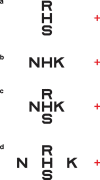Cortical reorganization after long-term adaptation to retinal lesions in humans
- PMID: 24227718
- PMCID: PMC3828461
- DOI: 10.1523/JNEUROSCI.2764-13.2013
Cortical reorganization after long-term adaptation to retinal lesions in humans
Abstract
Single-unit recordings demonstrated that the adult mammalian visual cortex is capable of reorganizing after induced retinal lesions. In humans, whether the adult cortex is capable of reorganizing has only been studied using functional magnetic resonance imaging, with equivocal results. Here, we exploited the phenomenon of visual crowding, a major limitation on object recognition, to show that, in humans with long-standing retinal (macular) lesions that afflict the fovea and thus use their peripheral vision exclusively, the signature properties of crowding are distinctly different from those of the normal periphery. Crowding refers to the inability to recognize objects when the object spacing is smaller than the critical spacing. Critical spacing depends only on the retinal location of the object, scales linearly with its distance from the fovea, and is approximately two times larger in the radial than the tangential direction with respect to the fovea, thus demonstrating the signature radial-tangential anisotropy of the crowding zone. Using retinal imaging combined with behavioral measurements, we mapped out the crowding zone at the precise peripheral retinal locations adopted by individuals with macular lesions as the new visual reference loci. At these loci, the critical spacings are substantially smaller along the radial direction than expected based on the normal periphery, resulting in a lower scaling of critical spacing with the eccentricity of the peripheral locus and a loss in the signature radial-tangential anisotropy of the crowding zone. These results imply a fundamental difference in the substrate of cortical processing in object recognition following long-term adaptation to macular lesions.
Figures




Similar articles
-
Transient attention equally reduces visual crowding in radial and tangential axes.J Vis. 2022 Aug 1;22(9):3. doi: 10.1167/jov.22.9.3. J Vis. 2022. PMID: 35921089 Free PMC article.
-
Radial-tangential anisotropy of crowding in the early visual areas.J Neurophysiol. 2014 Nov 15;112(10):2413-22. doi: 10.1152/jn.00476.2014. Epub 2014 Aug 13. J Neurophysiol. 2014. PMID: 25122703 Free PMC article.
-
Visual Working Memory Is Independent of the Cortical Spacing Between Memoranda.J Neurosci. 2018 Mar 21;38(12):3116-3123. doi: 10.1523/JNEUROSCI.2645-17.2017. Epub 2018 Feb 19. J Neurosci. 2018. PMID: 29459370 Free PMC article.
-
Crowding: a cortical constraint on object recognition.Curr Opin Neurobiol. 2008 Aug;18(4):445-51. doi: 10.1016/j.conb.2008.09.008. Epub 2008 Oct 27. Curr Opin Neurobiol. 2008. PMID: 18835355 Free PMC article. Review.
-
Contributions of Retinal Direction Selectivity to Central Visual Processing.Curr Biol. 2020 Aug 3;30(15):R897-R903. doi: 10.1016/j.cub.2020.06.002. Curr Biol. 2020. PMID: 32750354 Review.
Cited by
-
Visual Acuity Is Not the Best at the Preferred Retinal Locus in People with Macular Disease.Optom Vis Sci. 2018 Sep;95(9):829-836. doi: 10.1097/OPX.0000000000001229. Optom Vis Sci. 2018. PMID: 29877902 Free PMC article.
-
Rehabilitation Approaches in Macular Degeneration Patients.Front Syst Neurosci. 2016 Dec 27;10:107. doi: 10.3389/fnsys.2016.00107. eCollection 2016. Front Syst Neurosci. 2016. PMID: 28082876 Free PMC article. Review.
-
Learning to see again: biological constraints on cortical plasticity and the implications for sight restoration technologies.J Neural Eng. 2017 Oct;14(5):051003. doi: 10.1088/1741-2552/aa795e. Epub 2017 Jun 14. J Neural Eng. 2017. PMID: 28612755 Free PMC article. Review.
-
A method to characterize compensatory oculomotor strategies following simulated central vision loss.J Vis. 2020 Sep 2;20(9):15. doi: 10.1167/jov.20.9.15. J Vis. 2020. PMID: 32965480 Free PMC article.
-
The generality of the critical spacing for crowded optotypes: From Bouma to the 21st century.J Vis. 2021 Oct 5;21(11):18. doi: 10.1167/jov.21.11.18. J Vis. 2021. PMID: 34694326 Free PMC article.
References
Publication types
MeSH terms
Grants and funding
LinkOut - more resources
Full Text Sources
Other Literature Sources
